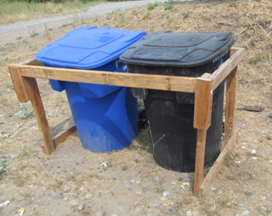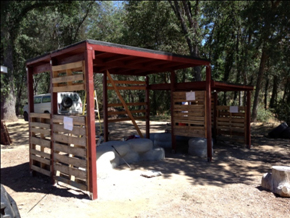Contact Pacific Southwest Waste Program
Pacific Southwest, Region 9
Serving: Arizona, California, Hawaii, Nevada, Pacific Islands, Tribal Nations
Success at Big Sandy

Tribe's Sustainable Plan is a Community Effort
A few years ago, Big Sandy Rancheria knew it had a waste disposal problem. Like many tribes in the region, the Rancheria had multiple issues with low recycling, open dumping of waste and insufficient community awareness or involvement with the problem. The enthusiastic leadership of the tribe’s Environmental Programs Manager, Jaime Collins, along with a solid waste management grant from EPA, allowed the Rancheria to bring the tribal community together to establish a sustainable waste management plan for all the residents of the Rancheria. Big Sandy’s new plan includes everything from recycling and composting to materials reuse and long-term economic planning.
The Big Sandy Rancheria is located roughly two miles east of the town of Auberry in Fresno county, and about 30 miles northeast of Fresno, California. The Rancheria is situated on a small valley floor in a rugged foothill portion of the Sierra Nevada National Forest. Backbone Creek and other seasonal washes run through the Rancheria and feed into the San Joaquin River.
The Rancheria includes about fifty homes and 151 residents. Eighty per cent of the community is low-to-middle income and thirty per cent do not have transportation. All water on the Rancheria is provided by community wells and is treated for uranium contamination.

Many of the waste issues faced by Big Sandy are common in this rural region of California, and are challenges faced by many other tribes. Community recycling sites were inconveniently located and recycling bins were small and often overflowed, resulting in recyclable materials dumped into trash containers. Additionally, all food waste was sent to landfills, instead of composted. Because of the remote location and lack of easy transportation to waste collection sites, reusable household items were often left on roadsides or in open dumps.
To address some of its waste management problems, the tribe developed an innovative waste management plan, using community outreach as a launching pad. The tribe conducted pilot studies focused on how to incorporate recycling and composting into the Tribe’s waste practices; they conducted extensive interviews with residents about garbage disposal, recycling, and how to improve recycling and diverting waste from landfills.

Trash and recycling bins were purchased and located throughout the community. Waste pick-up was increased from one day to two days per week to ensure that all trash was picked up. When dogs starting getting into the new waste bins, the community solved the problem by building frames to secure the bins. Once neighborhood outreach was completed and the pickup process refined,, the Rancheria was able to return to once per week pickups, meaning no additional ongoing costs were accrued and the bins were used consistently. As a result, the amount of recycling doubled, dumping decreased, and waste pickups became more efficient.
Tribal staff worked with Head Start, the tribal Family Activities Department (FAD), and residents who were interested in gardening, to add composting to Big Sandy’s waste management program. Compost bins were built for both the Head Start and the FAD gardens, using left over pallets from Home Depot donations. Staff was educated on composting, and posters for both kids and adults were developed as reminders of what is, and is not, compostable.

To ensure the success of the composting and gardening program, transportation was provided for tribal members to attend a free composting class at the and residents who were unable to attend were given a how-to flyer on composting. Again, using Home Depot pallet donations, compost bins were built for any resident requesting them. Ten per cent of residents now have compost bins. The Rancheria expects to continue to increase the amounts of compostable waste diverted from landfills.
During the project, learning about recycling and reuse was a multi-generational effort, with children and adults participating in two Do-It-Yourself (DIY) days. The DIY days were held in partnership with the Family Activities Department to engage youth and adults in hands-on projects making fun, useful items from what was once considered “trash.” The winter DIY Day revolved around making holiday ornaments from wine corks, old bulbs, plastic bottles, and rolled paper, while the spring DIY involved making bird-feeders out of milk cartons, worm bin planters from liter bottles, and lady bugs from egg cartons.

The community also completed several innovative projects using larger waste items. The FAD program recently renovated their garden from a raised garden to a “rain” garden. Wood from the raised garden, an old garden trellis, and windows from a deconstructed mobile home were repurposed into a greenhouse so the program could grow seedlings in a warm place until the last frost. Head Start is now using the greenhouse and will be painting it soon.
An open dump clean-up revealed a problem with waste tires being disposed of in dumps. This resulted in a proposal for bus stop benches made from used tires, which ultimately turned into a covered bus stop. This project was done in partnership with the Tribal Youth Council, the Environmental Programs Office, the Housing Office, and Everlasting Marks, a nonprofit which does sustainable construction projects with youth. Following up on the success of the bus stop, the tribal offices are planning future collaborations to increase recycling and reuse of building materials and other large waste items.

The project’s careful monitoring of potential cost savings is also impressive. Throughout the project the Rancheria developed a plan to maintain or decrease its existing waste management expenses. For example baling cardboard generated on the Rancheria for recycling will generate revenue, large-scale composting will offset the cost of mulch/fertilizer for a community garden, and a proposed hazardous waste collection center may generate enough revenue to sustain the jobs needed to operate it. A Swap Meet will take place three times per year which will also be a funding source. A pilot Swap Meet held in July 2013 was a success.
EPA’s Tribal Solid Waste Program works with many tribes to create waste management plans. In the case of Big Sandy Rancheria, the tribe was able to leverage EPA funding to create results far beyond developing a waste plan. Through hard work and cooperation, Big Sandy Rancheria was able to turn a persistent problem into innovative solutions which brought the community together and will provide environmental and economic benefits to the tribe for many years to come, inspiring us all as we strive for zero waste.
